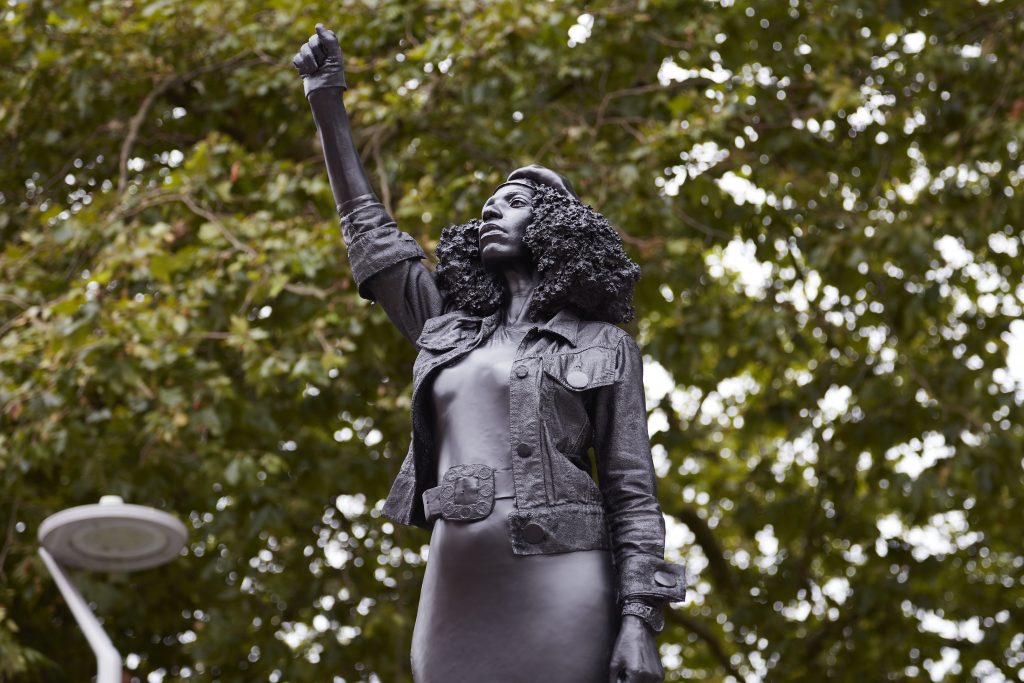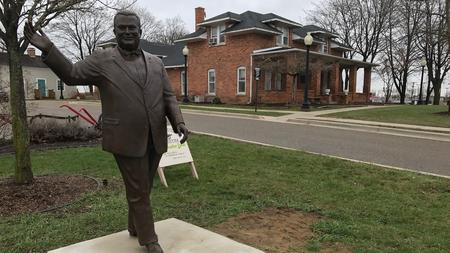Orville Hubbard. Lewis Cass. What Happens When Michigan’s Problematic Past Catches Up?
Historian Jamon Jordan and public art director Amina Cooper discuss the recent rash of street names, buildings and public statues coming under scrutiny for their racist origins.

America’s problematic past of racism, slavery and systemic oppression often finds itself fossilized in our street names, statues and buildings today.
Earlier this year, Governor Gretchen Whitmer renamed the Lewis Cass Building in Lansing, named after a former slave-holding territorial governor of Michigan, to the Elliott-Larsen Building.
“We know that removing a name from a building does not remove the problems of racism in society.” — Jamon Jordan, historian and tour guide
The name change aimed to separate the state’s capital from Cass and to instead honor Democratic representative Daisy Elliott and Republican representative Mel Larson, who were the main sponsors of Michigan’s anti-discrimination bill in 1976.
Listen: Educator and historian Jamon Jordan discusses the complicated history of street names in Detroit on CultureShift.

“Not only is [Lewis Cass] a slave owner, he was violating federal laws to be a slave owner and attempted to hide it,” says Jamon Jordan, educator and founder of the Black Scroll Network of History & Tours, during an interview on CultureShift on 101.9 WDET. “I would argue that any institution, building, monument that honors Lewis Cass ought to be removed or changed.”
Jordan says that Detroit’s role as a hub for the Underground Railroad and vast abolitionist movement are often highlights of Michigan’s history, pushing the narrative of the northern state being a “haven for freedom.”
But he argues there’s a largely untold history centered around Michigan’s role during the Civil War as a union state.
These institutions “obscured or omitted this long history of slavery in Michigan and in Detroit,” he says. “That longer narrative has made the South the villains in the story of slavery and the North the heroes. If you know the deeper story of America, slavery is an American institution, not just a Southern phenomenon.”
Statues fall
While Michigan’s governor has renamed a building in the state’s capital, there are currently no plans to change the name of Cass Avenue in Detroit. The prestigious city high school Cass Tech has also said they will not change their name.
While cities around the U.S. debate the renaming of buildings and streets, Confederate statues and monuments with a racist origin have continued to come under scrutiny with a mix of results.
Listen: Public art director Amina Cooper discusses the issues around removing Confederate statutes on CultureShift

In Dearborn, a statue of former mayor Orville Hubbard was removed in June because of his history of racism and segregation in the suburb of Detroit shortly after a bust of Christopher Columbus was removed from downtown Detroit by city officials.
“Right now, what we’re seeing is a struggle against some of the ways that public art has been utilized in the past to uphold white supremacy and reinforce black oppression,” says Amina Cooper, a public art director for the City of Charlotte, North Carolina, which has seen heated debates around its Confederate monuments among city officials and residents alike.
“The purpose of public art is to better reflect both the community and also our ideals and aspirations for who we are and who we want to be in the future,” adds Cooper, who recently wrote a blog post on the Americans for the Arts website.
Cooper, who also serves on the advisory board for the American for the Arts Public Art Network, says the removal of problematic public art can be complicated. She says many Confederate monuments in the U.S. were erected during the Civil Rights era as a protest against the mainly African-American social justice movement.
“A lot of these monuments have protections that are written into code and that are designated as historic landmarks, so it makes it very difficult for us to go through the normal process of de-accessioning these works,” says Cooper. “That is why we’re seeing people forcibly removing them because the city is either unwilling or unable to de-access them.”
Jamon Jordan says removing a monument or changing a street name can only do so much.
“We know that removing a name from a building does not remove the problems of racism in society,” says Jordan.
Trusted, accurate, up-to-date
WDET is here to keep you informed on essential information, news and resources related to COVID-19.
This is a stressful, insecure time for many. So it’s more important than ever for you, our listeners and readers, who are able to donate to keep supporting WDET’s mission. Please make a gift today.
